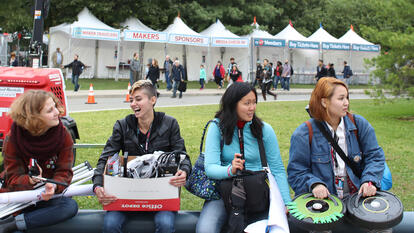Alumnae Celebrate Sisterhood with Jewelry Made by One of Their Own

Jewelry can make powerful statements, but can it also reinforce the bonds among women? U.K.-based writer Sarah Burton said yes in a recent article in the New York Times: “When women give each other jewelry, they are reclaiming the beauty of the thing itself: It’s an emblem not of patriarchy but of sisterhood.”
For Cavan Mahony ’90, a fashion, beauty, and lifestyle consultant living in London, “sisterhood” means Wellesley, and the jewelry she and several alumnae friends give and collect is created by Catherine Prevost ’89, a London-based luxury jeweler.
“When we go to lunch we compare our rings. ‘What’s that one? I don’t have it, I need to get one.’” Mahoney said in the Times article. “It feels like we share the same exciting secret insight into something special. We have a friend with such great talent, and we’re women who recognize it.”
Prevost, who moved to London shortly after graduating and getting married, said via email that women giving jewelry to one another is a “very sisterly action” that has been a tradition since time began. “It’s a way of saying, ‘I cherish you in my life,’” she explained.
More recently, women have begun buying themselves expensive “statement pieces,” especially rings. “It used to be that women would have to wait for a man to buy them a ring, but now, thank goodness, that is a thing of the past,” Prevost said.
Prevost didn’t expect to become a jewelry maker when she majored in art history and political science at Wellesley; instead, she envisioned herself becoming an art lawyer.
After she moved to London, she took a course in fine and decorative art that focused on furniture and jewelry. The experience prompted her to start designing big, bold pieces—the kind of jewelry she wanted to wear but couldn’t find in stores.
Prevost made her jewelry by hand at first, working with unusual materials such as wood and green agate. In 1991, she launched her first collection in London, which was picked up and sold internationally by Neiman Marcus, Saks Fifth Avenue, and Harrods.
She spent the next few years in search of sources for stones and manufacturers that could produce her designs. In 1997, she opened a boutique in London that soon became known as an A-list destination, attracting celebrities including Kate Moss, Gwyneth Paltrow, and Sarah Jessica Parker.
After the birth of her fourth child, in 2007, Prevost closed her shop to focus on motherhood. She continued to design for herself and friends, however, and in 2014 she launched a new collection of cocktail rings, exotic wood and diamond rings, earrings, and long beaded necklaces.
Prevost said the boldness of her jewelry reflects the boldness and willingness to take risks she learned as a student at Wellesley. She also learned to push her boundaries and follow her passions, and she found that her fellow Wellesley students were—and would continue to be—her staunchest supporters.
“I celebrate my friends by designing jewelry for them,” said Prevost, whose newest creation is a sisterhood necklace she created for a Wellesley alumna. The piece features the birthstones of several of the woman’s friends, with each woman’s initial on the back of her birthstone.
Prevost never gets tired of working with jewels because they “empower women to express themselves in their own individual styles,” she explained. “I also love working with other women in my line of business because we always see eye to eye.”
For example, Prevost was in Bali in January and met a woman who hand-makes beaded necklaces. “Even though we speak different languages, we worked together to create something beautiful,” she said.



